Difference between revisions of "Heading Alignment Cone"
Jump to navigation
Jump to search
m |
m |
||
| Line 1: | Line 1: | ||
[[Image:STS-117 approach path.gif|thumb|200px|right|The HAC is cleary shown on the flight path of STS-117.]] | [[Image:STS-117 approach path.gif|thumb|200px|right|The HAC is cleary shown on the flight path of STS-117.]] | ||
| − | The '''Heading Alignment | + | The '''Heading Alignment Cone (HAC)''' is a virtual truncated cone, used to guide NASA's [[Space Shuttle]] onto the centerline of a runway for landing. Some publications also name it ''Heading Alignment Cylinder'', but that is not the official NASA terminology. The radius of a HAC is about 18,000 feet in 22 NM altitude. |
| − | + | For alignment with the runway, the surface of the '''HAC''' is followed by the [[Shuttle]] orbiter until runway alignment is achieved, with the point, where the final glide path meets the '''HAC''', being called '''Nominal Energy Point''' (NEP). | |
| − | |||
| − | |||
Revision as of 17:09, 26 June 2007
The Heading Alignment Cone (HAC) is a virtual truncated cone, used to guide NASA's Space Shuttle onto the centerline of a runway for landing. Some publications also name it Heading Alignment Cylinder, but that is not the official NASA terminology. The radius of a HAC is about 18,000 feet in 22 NM altitude.
For alignment with the runway, the surface of the HAC is followed by the Shuttle orbiter until runway alignment is achieved, with the point, where the final glide path meets the HAC, being called Nominal Energy Point (NEP).
